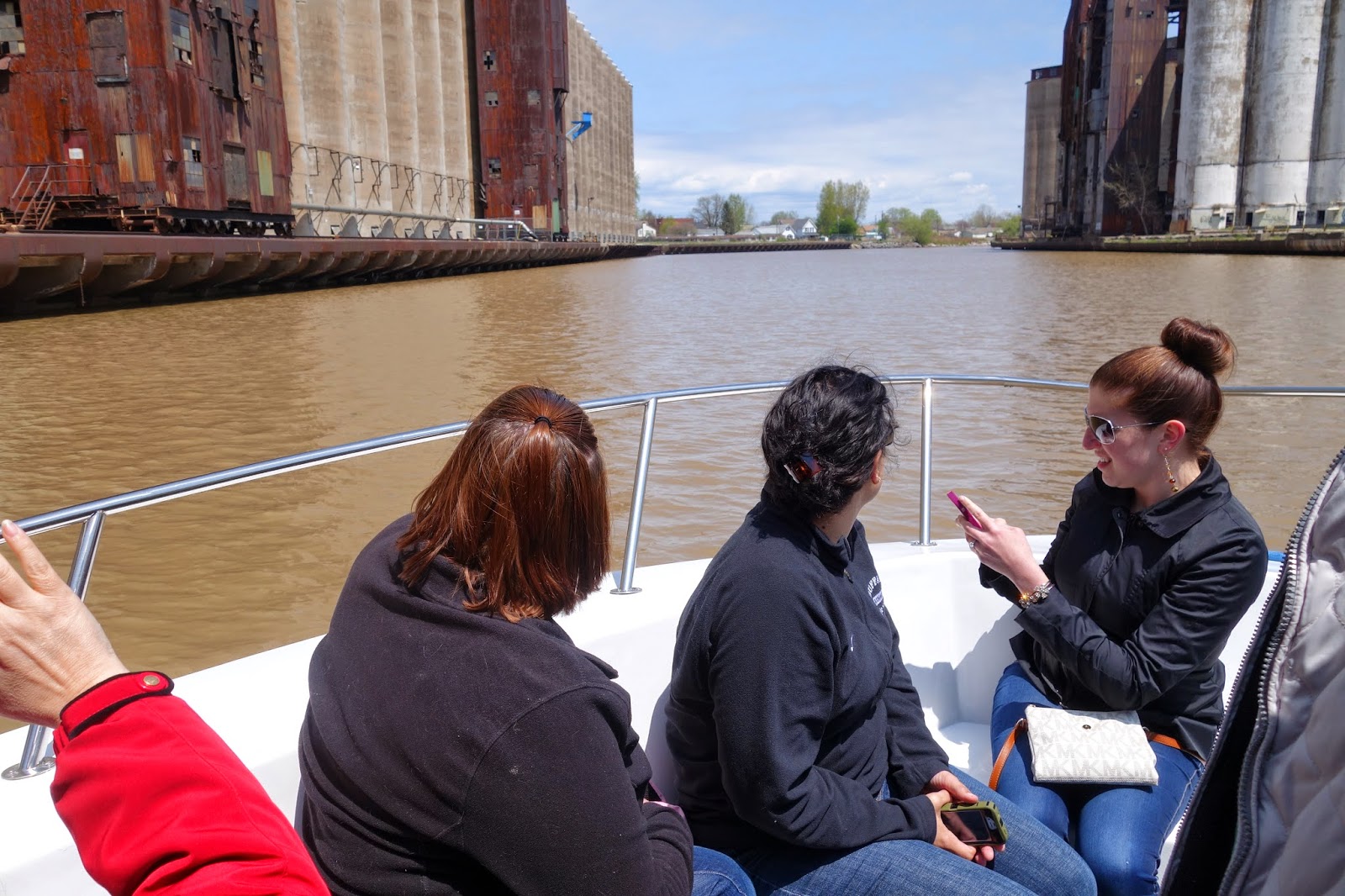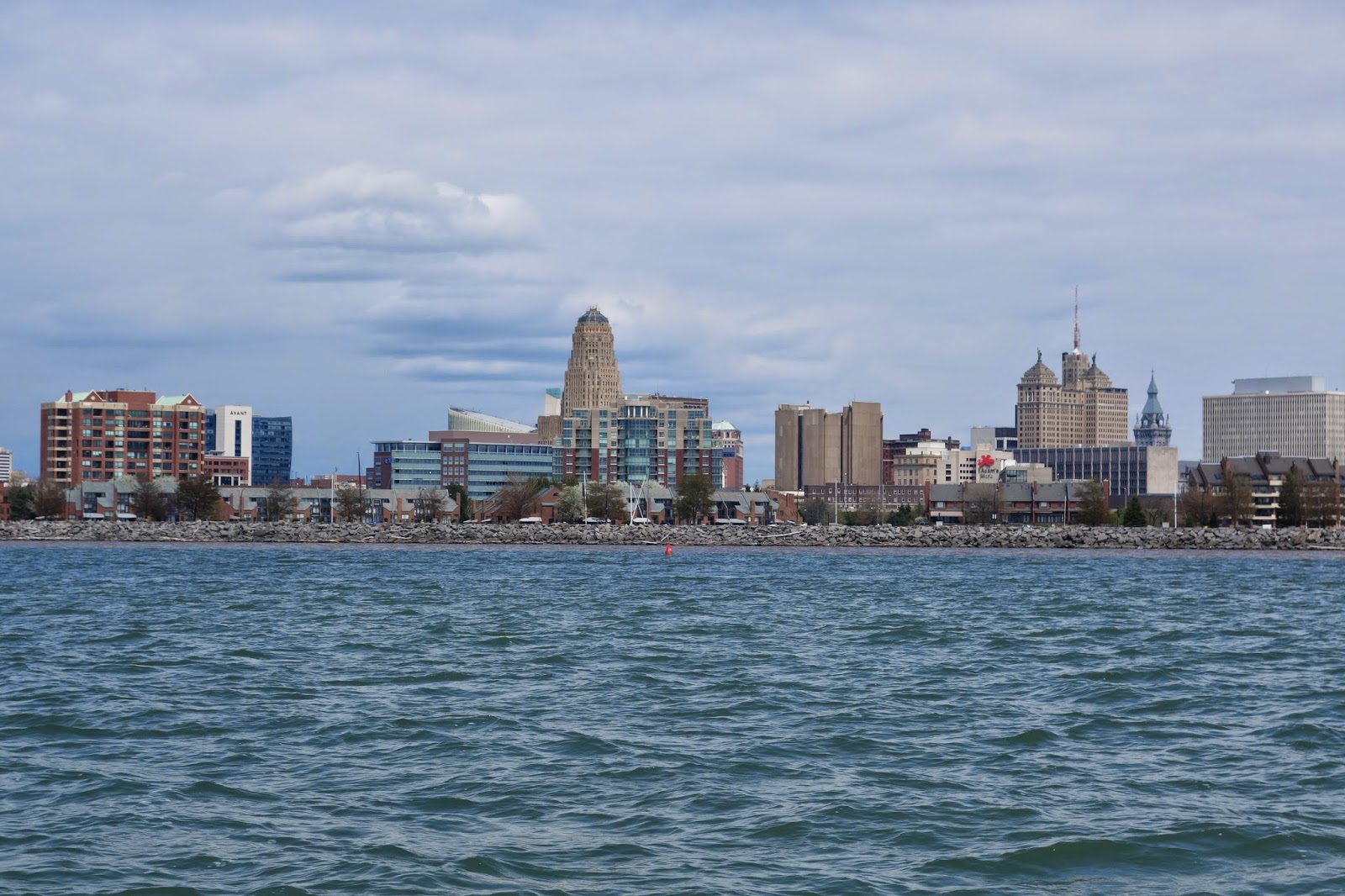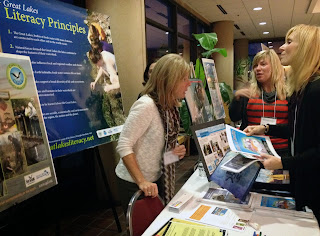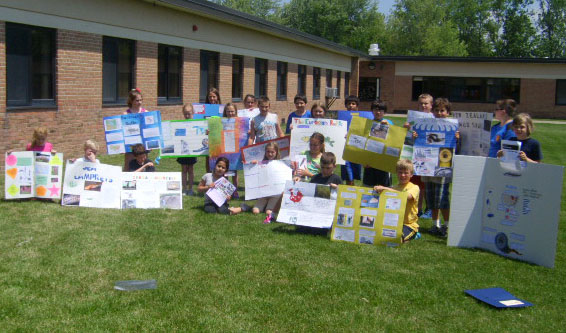January 28th, 2015 by iisg_superadmin
A closer look at web tools and sites that boost research and empower Great Lakes communities to secure a healthy environment and economy.
For over two years, the Limno Loan program has been shaking up science class across the Great Lakes region. Coordinated by IISG and the U.S. EPA Great Lakes National Program Office, the program gives students an opportunity to collect water quality data from local waterways with the same kind of monitoring sensors used by scientist aboard the R/V Lake Guardian.

And now, teachers can take their Hydrolab projects one step further with help from IISG’s new Limno Loan site. In addition to information about the equipment and the parameters it measures, the site provides lessons and activities to help teachers K-12 better integrate the Hydrolab into their aquatic science sections.
The activities, most of which were created by educators who used the equipment in their own classrooms, focus on demonstrating the connections between water quality, aquatic food webs, and human activities. Sample water quality data sheets are also available. The website also provides a unique opportunity for classes to share their data and compare it to information collected by fellow students across the region.
New activities will be added as they are developed, so be sure to check back later. You can also read more about how the Limno Loan program has helped improve student understanding of Great Lakes sciences in our Winter 2012 Helm.
November 3rd, 2014 by iisg_superadmin
After decades of remediation work, two Michigan sites are no longer considered Areas of Concern (AOCs). The U.S. Environmental Protection Agency officially removed Deer Lake in the Lake Superior basin and White Lake in the Lake Michigan Basin from the list of toxic hot spots last week.
These are the third and fourth U.S. sites to be delisted since a 1987 cleanup agreement with Canada identified areas hit hardest by legacy pollutants like PCBs and mercury. The Oswego River in New York became the first in 2006, and Pennsylvania’s Presque Isle Bay was delisted last year.

From the Detroit Free Press
The Deer Lake AOC, along the southern shore of Lake Superior on the Upper Peninsula, was listed because of mercury contamination that leached into water flowing through an abandoned iron mine, as well as other pollutants. Mercury contamination in fish—and reproductive problems—also were documented in animals and birds, including bald eagles.
The remediation efforts included a Great Lakes Restoration Initiative grant for $8 million that helped pay for a project diverting water from Partridge Creek. It previously fed the stream flowing through old mine workings under Ishpeming, which then ran into another creek and into Deer Lake.
The White Lake AOC was on Lake Michigan in Muskegon County and had been contaminated by pollution—especially organic solvents—from tannery operations, chemical manufacturing and other sources, degrading fish and wildlife habitats.
A $2.5-million grant was used to remove contaminated sediment and restore shoreline, with more than 100,000 cubic yards being removed. Read more
More than two dozen AOCs remain throughout the Great Lakes states. But as many as 10 are targeted for completion in the next five years thanks in part to funding from the Great Lakes Restoration Initiative, which will enter its second phase next year.
Two of the sites slated for delisting are the Buffalo and Grand Calumet rivers, where IISG’s Caitie McCoy has partnered with federal, state, and local groups under the Great Lakes Legacy Act to connect nearby communities with the remediation and restoration. A big part of this work has focused on integrating environmental cleanup projects into the classroom with place-based curriculum and stewardship projects.
***Deer Lake in Ishpeming. Credit: Stephanie Swart, Michigan Department of Environmental Quality.
September 16th, 2014 by iisg_superadmin
Our education team is at it again! Allison Neubauer wrote in with this exciting announcement:
 Teachers across the Great Lakes region—have we got a treat for you! You can now explore creative projects from all-star educators to spark new ideas and read important tips for getting your students involved in the effort to “nab” local aquatic invaders.
Teachers across the Great Lakes region—have we got a treat for you! You can now explore creative projects from all-star educators to spark new ideas and read important tips for getting your students involved in the effort to “nab” local aquatic invaders.
The IISG education team has been working hard to compile model projects that successfully tie together AIS education and community stewardship. Our revamped Nab the Aquatic Invader! website will help you up your game—and the new-and-improved Top Desk Administrator is your one-stop-shop for project ideas.
Community stewardship projects like the ones highlighted here are an exceptional tool for pushing students beyond rote memorization and providing them with an opportunity to apply their knowledge in ways that have positive impacts on their communities.
Preview outstanding examples of student work, ranging from fun informational activity books to catchy musical compilations. When you’re done perusing, read the summary reports written by the teachers responsible for these successful activities for information on how to plan and implement similar projects in your own classroom.
The Nab the Aquatic Invader! website is the place for the latest and greatest invasive species project models, information, and activities.
June 27th, 2014 by iisg_superadmin
 The Great Lakes Legacy Act remediation project on the Buffalo River resumed June 16, and will remove 500,000 cubic yards of contaminated sediment from the river, then replace native aquatic plants to help restore the local ecosystem.
The Great Lakes Legacy Act remediation project on the Buffalo River resumed June 16, and will remove 500,000 cubic yards of contaminated sediment from the river, then replace native aquatic plants to help restore the local ecosystem.
18 teachers from grades 4-11 attended the workshop to learn more about the restoration project and the curriculum, and were treated to hands-on activities and a tour of the river area to help bring the project and its impacts into their classes.
 “It’s great to see so many educators come out to this kind of workshop,” Caitie said. “Many teachers want to incorporate place-based learning in their science curriculum, but may lack resources to do so. Now instead of using distant examples like rainforests to teach science, they can use their neighborhood rivers and lakes. These are places that students can visit and experience the science in person. They develop a love for these places and want to protect them.”
“It’s great to see so many educators come out to this kind of workshop,” Caitie said. “Many teachers want to incorporate place-based learning in their science curriculum, but may lack resources to do so. Now instead of using distant examples like rainforests to teach science, they can use their neighborhood rivers and lakes. These are places that students can visit and experience the science in person. They develop a love for these places and want to protect them.”
June 17th, 2014 by iisg_superadmin
The efforts of an Illinois teacher to bring Great Lakes science into the classroom were brought center stage in the latest edition of Teacher Features, a monthly online series that showcases outstanding educators in the Great Lakes region.
Eileen DeJong, a teacher at Suak Village’s Rickover Junior High, is one of 14 teachers from Illinois and Indiana who learned about local aquatic ecosystems and ideas for hands-on stewardship activities at last summer’s B-WET workshop. In this edition, she talks about the importance of raising awareness of Great Lakes issues, past classroom projects, and her plans for the future.
From Teacher Features:
1. Why do you think it’s important to infuse Great Lakes topics in education?
I think it’s important that I incorporate information about our Great Lakes into my teaching because our school is impacted in many ways by one of the Great Lakes (Lake Michigan). Students respond to information that makes sense to them and that affects their life, and because Lake Michigan is so close to us (within 45 minutes); it’s a great way to get students involved in current environmental issues. We can study about aquatic invasive species affecting Lake Michigan and then GO TO Indiana Dunes, for example, and conduct experiments there. Or … even closer to home, we can study about invasive species harming our local forests, and then GO TO nearby forest preserves and volunteer. It’s all about making connections. Studying the Great Lakes topics make science REAL for my students and helps foster natural curiosity about their surroundings. It is also important because the problem of invasive species is a current environmental issue, and it’s happening in our own backyard. It encourages my students to become knowledgeable about factors affecting their living environment and to become activists for change.
Continue reading at the link above.
Teacher Features is part of the Center for Great Lakes Literacy’s (CGLL) ongoing efforts to boost awareness of issues facing the Great Lakes watershed and inspire greater community stewardship. The group is led by Sea Grant educators throughout the region and conducts numerous teacher trainings each year, including the annual Shipboard Science workshop.
November 15th, 2013 by Irene Miles
The 3rd Annual Great Lakes Place-based Education Conference, November 7-9 in Grand Rapids, Michigan, brought together over 200 teachers, community representatives, non-profit organization educators, and more. The conference gives teachers an opportunity to incorporate the latest place-based research and education concepts about the Great Lakes into their lessons, encouraging student stewardship, continuing science education, and community development.
 IISG’s Robin Goettel attended the conference and organized a poster session, “Center for Great Lakes Literacy: Connecting Educators, Scientists and Citizens.” The Center for Great Lakes Literacy (CGLL) “engages educators, students, scientists, and lifelong learners in stewardship and citizen science activities to help protect and restore Great Lakes watersheds.”
IISG’s Robin Goettel attended the conference and organized a poster session, “Center for Great Lakes Literacy: Connecting Educators, Scientists and Citizens.” The Center for Great Lakes Literacy (CGLL) “engages educators, students, scientists, and lifelong learners in stewardship and citizen science activities to help protect and restore Great Lakes watersheds.”
According to Robin, “A major focus of this exhibit was creating awareness of Great Lakes Literacy Principles – a great foundation from which to create an environmental stewardship ethic. CGLL specialists shared exciting educator opportunities including ship-based and shoreline workshops focusing on the latest Great Lakes issues. Visitors learned about water quality monitoring equipment they can use with their students made available courtesy of the USEPA GLNPO Limno Loan program. Participants also found out about Great Lakes Awareness Days that will be offered throughout the region.”
 Representatives of the CGLL program from seven Great Lakes Sea Grant programs were on hand to talk with attendees about the wide array of resources available, many specifically tailored to the environmental needs and issues of their region. Classroom resources were also available, including Fresh and Salt and Greatest of the Great Lakes curricula, as well as the Dose of Reality newspaper activity guide that covers the disposal of unwanted medicines and personal care products.
Representatives of the CGLL program from seven Great Lakes Sea Grant programs were on hand to talk with attendees about the wide array of resources available, many specifically tailored to the environmental needs and issues of their region. Classroom resources were also available, including Fresh and Salt and Greatest of the Great Lakes curricula, as well as the Dose of Reality newspaper activity guide that covers the disposal of unwanted medicines and personal care products.
November 1st, 2013 by Irene Miles
The Illinois Science Education Conference, recently held in Tinley Park, featured more than 150 presentations, symposiums, and exhibits aimed at providing resources and professional development opportunities for science teachers throughout the state. Illinois-Indiana Sea Grant’s education team was among the many exhibitors participating, and offered materials and presentations to help introduce Great Lakes literacy principles to the teachers present.
 IISG’s Robin Goettel and Terri Hallesy led two presentations to give teachers information and guidance on getting their students interested in Great Lakes science and stewardship. Several educational resources were also made available for the teachers to utilize in their classes.
IISG’s Robin Goettel and Terri Hallesy led two presentations to give teachers information and guidance on getting their students interested in Great Lakes science and stewardship. Several educational resources were also made available for the teachers to utilize in their classes.
Anjanette and Corrie staffed two tables in the exhibit hall. One focused on AIS and featured “Nab the Aquatic Invader” information, invasive species watch cards, games, and suggested alternatives to releasing classroom pets into the wild (the HabitattitudeTM project). The second table focused on several different curricula and stewardship programs offered by IISG. CDs of Fresh and Salt and Greatest of the Great Lakes were available, as well as flash drives with The Medicine Chest and Sensible Disposal of Unwanted Meds. Teachers were very excited to receive these because they were so compact and comprehensive, with several asking if they could give a second one to their colleagues.
Two Great Lakes Restoration Initiative projects were highlighted in our displays – Great Lakes Organisms in Trade Initiative-Research, Outreach and Education and Undo the Great Lakes Chemical Brew.
September 19th, 2013 by Irene Miles
Illinois-Indiana Sea Grant’s Caitie McCoy and others have just completed work on a new curriculum for elementary and high school science students.
Helping Hands: Restoration for Healthy Habitats offers lessons and hands-on activities to connect students in the Great Lakes with recent or ongoing cleanup and restoration projects happening in their communities. The range of activities offers new ways to engage students with real-life examples that show environmental science in action.
Teachers interested in having Sea Grant lead the curriculum in their school should contact Caitie McCoy. Caitie can work with the teacher to customize curriculum to meet school-specific needs. The curriculum expands Great Lakes literacy among students, many of whom may become future researchers and educators.
Community leaders in Areas of Concern that would like to help Sea Grant lead or set up an educational program are also encouraged to contact Caitie. The complete curriculum is free to download at the link above.
May 14th, 2013 by Irene Miles
The SeaPerch Program, sponsored by the Office of Naval Research, brings robotics and underwater science together to enhance classroom activities and curricula for a variety of grade levels. Illinois-Indiana Sea Grant recently sponsored a contest to give away several of the kits to teachers of grades 6-12.
From The Great Lakes Echo:
“The Illinois-Indiana Sea Grant offers grade 6-12 teachers a chance to win a free kit to build a remotely operated underwater vehicle. The SeaPerch kit normally costs $194.
SeaPerch, a program started about five years ago by Massachusetts Institute of Technology professors, provides remotely operated underwater vehicles and lesson plans to teachers to improve the curriculum in science, mathematics and engineering in primary education across the country.”
Follow the link above to read the complete story, and visit the SeaPerch homepage for more information about the program, including photos, video, curricula, and more.







